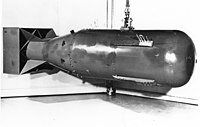
Photo from wikipedia
To evaluate the association between a vessel size index (VSIMRI) derived from dynamic susceptibility contrast (DSC) perfusion imaging using a custom spin-and-gradient echo echoplanar imaging (SAGE-EPI) sequence and quantitative estimates… Click to show full abstract
To evaluate the association between a vessel size index (VSIMRI) derived from dynamic susceptibility contrast (DSC) perfusion imaging using a custom spin-and-gradient echo echoplanar imaging (SAGE-EPI) sequence and quantitative estimates of vessel morphometry based on immunohistochemistry from image-guided biopsy samples. The current study evaluated both relative cerebral blood volume (rCBV) and VSIMRI in eleven patients with high-grade glioma (7 WHO grade III and 4 WHO grade IV). Following 26 MRI-guided glioma biopsies in these 11 patients, we evaluated tissue morphometry, including vessel density and average radius, using an automated procedure based on the endothelial cell marker CD31 to highlight tumor vasculature. Measures of rCBV and VSIMRI were then compared to histological measures. We demonstrate good agreement between VSI measured by MRI and histology; VSIMRI = 13.67 μm and VSIHistology = 12.60 μm, with slight overestimation of VSIMRI in grade III patients compared to histology. rCBV showed a moderate but significant correlation with vessel density (r = 0.42, p = 0.03), and a correlation was also observed between VSIMRI and VSIHistology (r = 0.49, p = 0.01). The current study supports the hypothesis that vessel size measures using MRI accurately reflect vessel caliber within high-grade gliomas, while traditional measures of rCBV are correlated with vessel density and not vessel caliber.
Journal Title: Scientific Reports
Year Published: 2018
Link to full text (if available)
Share on Social Media: Sign Up to like & get
recommendations!